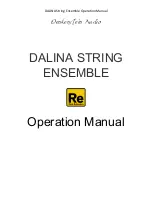
-66-
We’ve been producing tones with audio oscillators
for so long that it might seem as if there’s no other
way to produce tones from electronic circuits. Not so
– a multivibrator made from NAND gates does the
job nicely.
When you finish wiring this circuit, connect the
earphone to terminals 13 and 14 and set the switch
to A to turn on the power. You’ll hear a tone that is
produced by the multivibrator. Try changing the
value of the capacitors from 0.1
μ
F to 0.5
μ
F. What
effect does this have on the sound you hear?
You might also want to try different capacitors in this
project. Don’t try using any of the electrolytic
capacitors, however (terminals 111-118). Try to
arrange the circuit so you can switch different value
capacitors in and out of this circuit to vary the tone.
Can you think of ways to use this circuit with any
other digital circuits?
Notes:
EXPERIMENT #49: TTL TONE GENERATOR
Wiring Sequence:
o
49-131
o
50-51-77-109
o
52-53-54-60-59-75-78
o
55-57-56-76-110
o
62-121
o
119-132
o
58-13-EARPHONE
o
61-14-EARPHONE
Schematic
Содержание EP-130
Страница 11: ... 11 I ENTERTAINMENT CIRCUITS ...
Страница 26: ... 26 II BASIC SEMICONDUCTOR AND COMPONENTS CIRCUITS ...
Страница 36: ... 36 III LED DIGITAL DISPLAY CIRCUITS ...
Страница 41: ... 41 IV A TOUR THROUGH DIGITAL CIRCUITS ...
Страница 49: ... 49 V MORE ADVENTURES WITH DIGITAL CIRCUITS ...
Страница 64: ... 64 VI THE WORLD OF TRANSISTOR TRANSISTOR LOGIC ...
Страница 77: ... 77 VII APPLICATION CIRCUITS BASED ON THE OSCILLATOR ...
Страница 88: ... 88 VIII BASIC OPERATIONAL AMPLIFIER CIRCUITS ...
Страница 116: ... 116 IX MORE ADVENTURES WITH OPERATIONAL AMPLIFIERS ...
Страница 129: ... 129 X COMMUNICATION CIRCUITS ...
Страница 136: ... 136 XI TESTING AND MEASURING CIRCUITS ...
















































